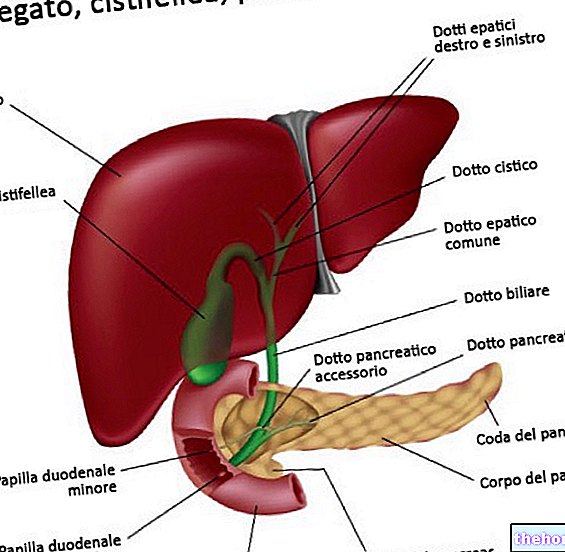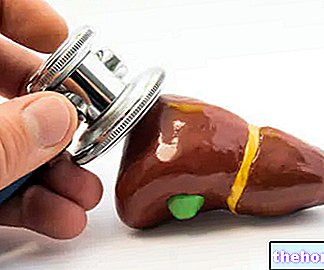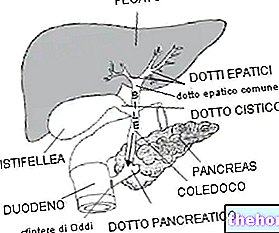Definition and Causes
Sclerosing cholangitis is an inflammatory disease of the liver, which recognizes its causal element in the inflammation of the bile ducts. The inflammatory process, which can affect the biliary tree at different levels, results in cicatricial processes of the intra and / or extrahepatic ducts, in which the bile produced by the liver flows.
As a result, narrowings (stenosis) and adhesions form that prevent normal biliary outflow into the intestine (from the intrahepatic canaliculi to the common hepatic duct, and from there to the gallbladder and cystic duct, then to the duodenum). fibrotic - rather slow but inexorable - typically leads to occlusion of the bile ducts over a period of 10-15 years with the development of liver cirrhosis and portal hypertension.
In addition, people with sclerosing cholangitis run a greater risk of developing cholangiocarcinoma, a malignant tumor of the bile ducts.

Figure: Comparison of healthy (left) and inflamed (right) major bile ducts.
Note the narrowing of the bile ducts caused by the inflammatory process that characterizes sclerosing cholangitis. From the site: epainassist.com
Sclerosing cholangitis is divided into:
- Primary or primary sclerosing cholangitis: when it is not possible to identify a disease responsible for biliary fibrosis → the damage is often considered immune-mediated, as evidenced by the frequent association of primary sclerosing cholangitis and diseases of autoimmune etiology, eg. ulcerative colitis, Crohn's disease, chronic autoimmune pancreatitis, sarcoidosis. Other pathogenetic theories, less accredited today, attribute a role to bacterial toxins and to the infectious agents themselves. Primary sclerosing cholangitis is about twice as common in men than in women and is rare in children, manifesting itself electively in the third to sixth decade of life.
- secondary sclerosing cholangitis: when it follows a clinically identifiable underlying disease → the main causes of secondary sclerosing cholangitis include the presence of stones inside the bile ducts, recurrent pancreatitis, surgery on the biliary tree, AIDS or "injection of chemotherapy drugs through the hepatic artery."
Symptoms
For further information: Sclerosing Cholangitis Symptoms
Some patients may be asymptomatic for many years, and continuous monitoring may be required in these cases. The clinical picture associated with sclerosing cholangitis is extremely variable, but generally progressive and complicated - in most cases - from the evolution towards a picture of liver cirrhosis with severe impairment of liver function.
Jaundice, itching, weight loss, weakness, poor appetite and hepatic tenderness (pain in the right hypochondrium), are the classic symptoms of onset, which over time can become complicated evolving into those typical of portal hypertension and liver failure: edema, ascites, esophageal varices, hemorrhoids, splenomegaly.
Diagnosis and treatment
Faced with the clinical suspicion, sclerosing cholangitis is diagnosed through an examination known as perendoscopic retrograde cholangio-pancreatography (ERCP), during which a contrast medium is injected directly into the biliary tree so that its structure can be better studied through radiographic images. . A flexible tube equipped with a camera and a light source is made to go down through the mouth until it reaches the duodenum, in particular up to the papilla of Vater (where the biliary and pancreatic tracts enter the intestine). Through this sphincter structure it is injected. the contrast medium necessary to study the structure of the biliary tract through X-ray images. For the monitoring of patients with already diagnosed sclerosing cholangitis it is possible to use magnetic resonance cholangio-pancreatography (MRCP), which produces images of the biliary tree by exploiting the high intensity of the bile signal (which appears white ), compared to the surrounding tissues that generate poor signal (so they appear dark). CT scan can also play a complementary role to cholangiography.
Since the fibrotic process of the bile ducts is not reversible, drug therapy is based on the control of associated symptoms. Itching, for example, can be controlled by the use of antihistamines and prevented by the use of bile acid sequestering resins.
- Corticosteroids, aziatoprine, penicillamine and methotrexate have given variable results and are associated with important toxic effects. Ursodeoxycholic acid (ursodiol) may reduce pruritus and improve biochemical parameters, but has not been shown to alter history natural disease
The integration of the diet with fat-soluble vitamins (vitamins A, D, E and K) in tablets prevents specific deficiencies, deriving from the reduced absorption of the same due to the lack of the emulsifying activity of the bile. Antibiotics can be taken to prevent episodes of bacterial cholangitis (gallbladder infection), which is very common in people with sclerosing cholangitis.
Liver transplantation remains the only definitive cure to resolve primary sclerosing cholangitis, reserved for the most serious cases complicated by liver failure. Minimally invasive laparoscopic and endoscopic surgery (operative ERCP) can still be helpful: the doctor can position stents in correspondence with biliary obstructions, dilating the walls, or removing them and then welding the residual ends of the bile duct.























-nelle-carni-di-maiale.jpg)




